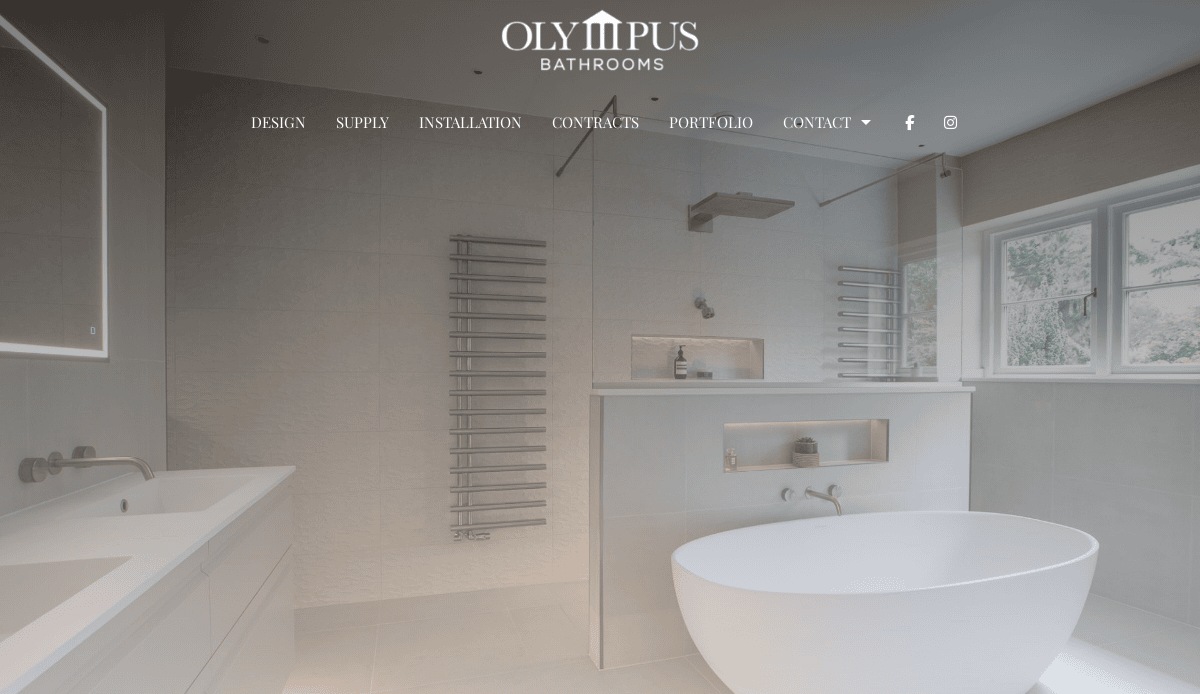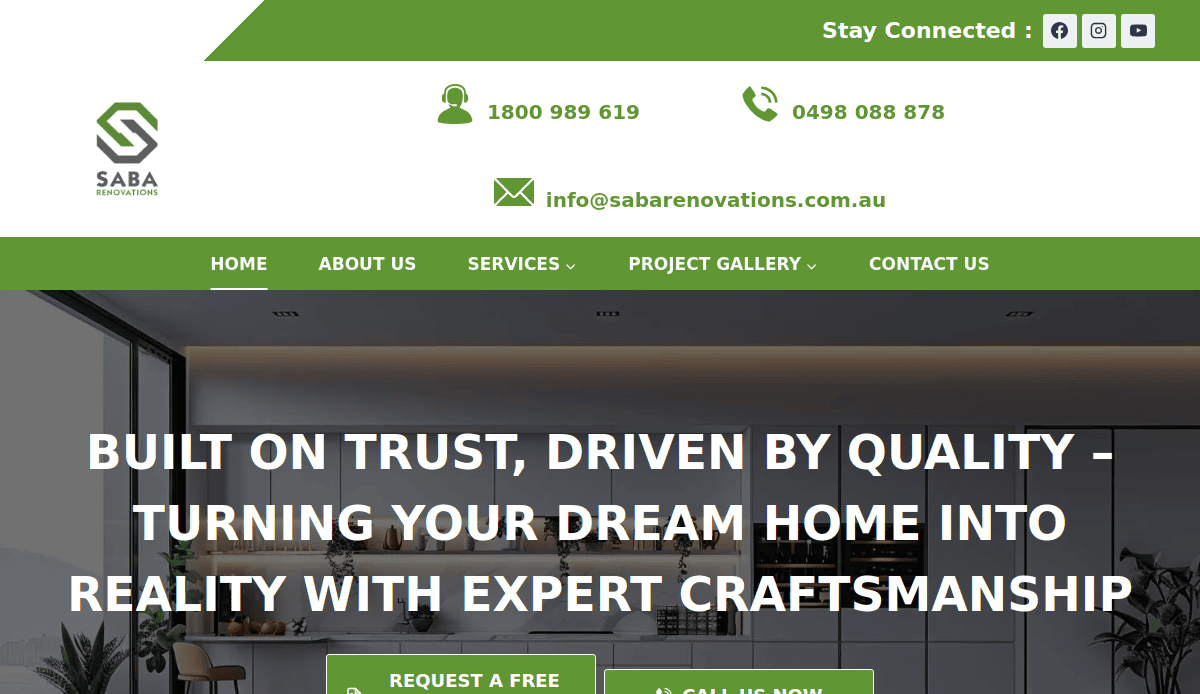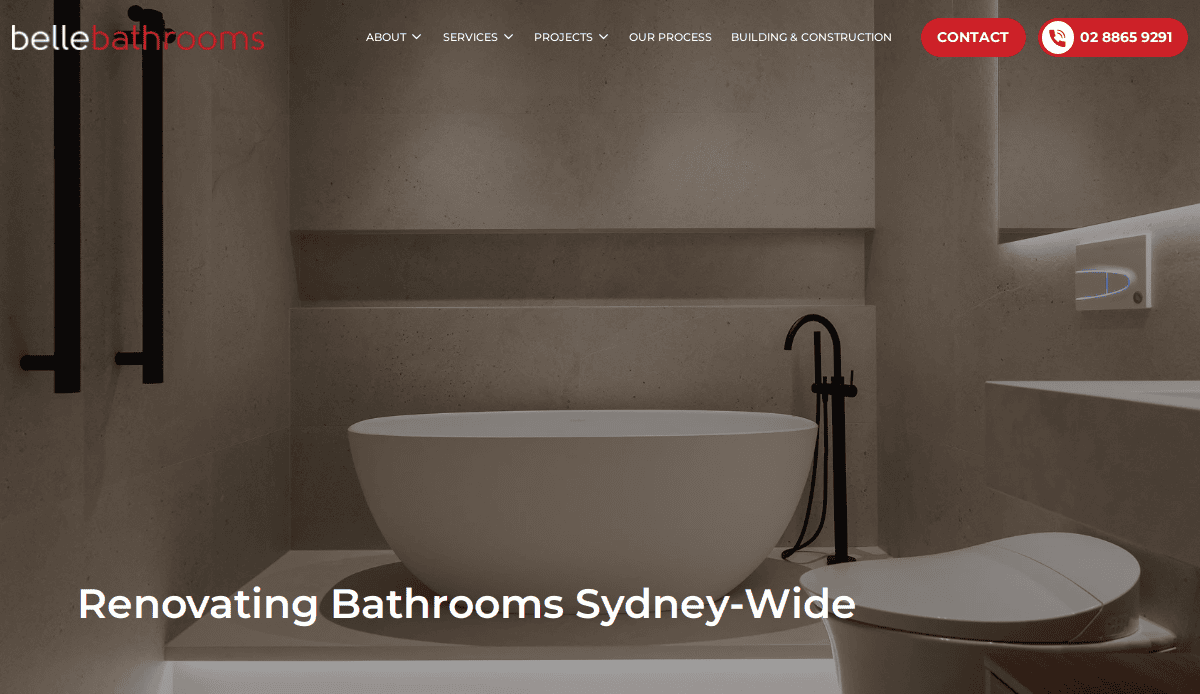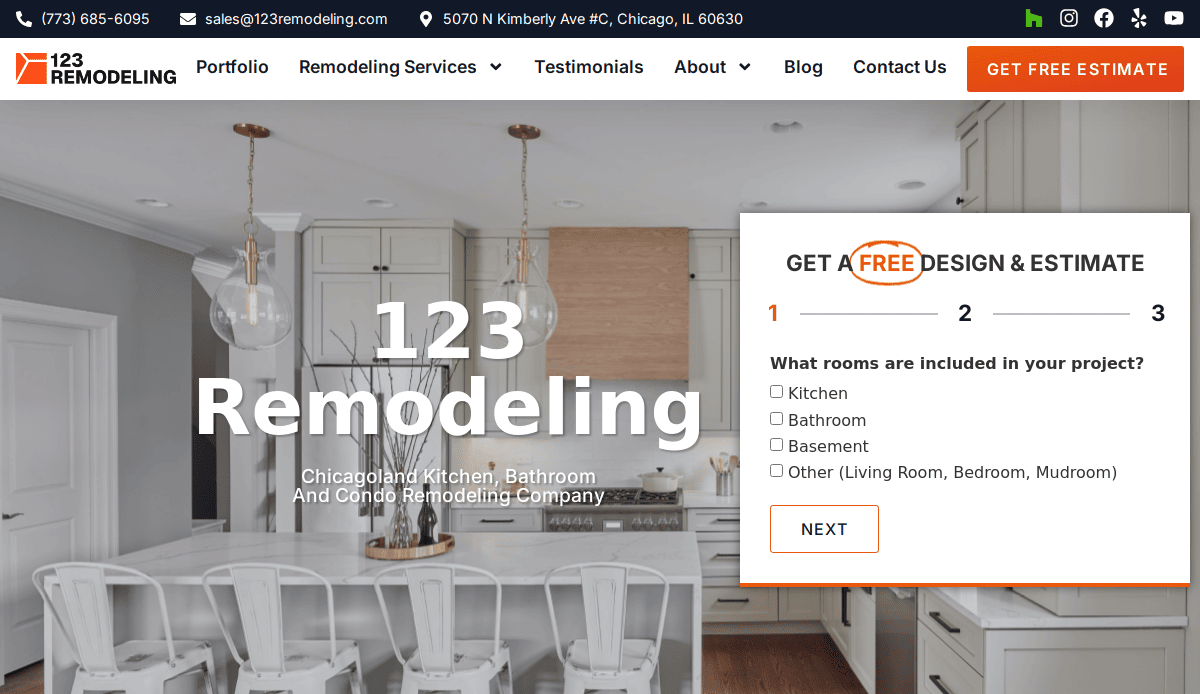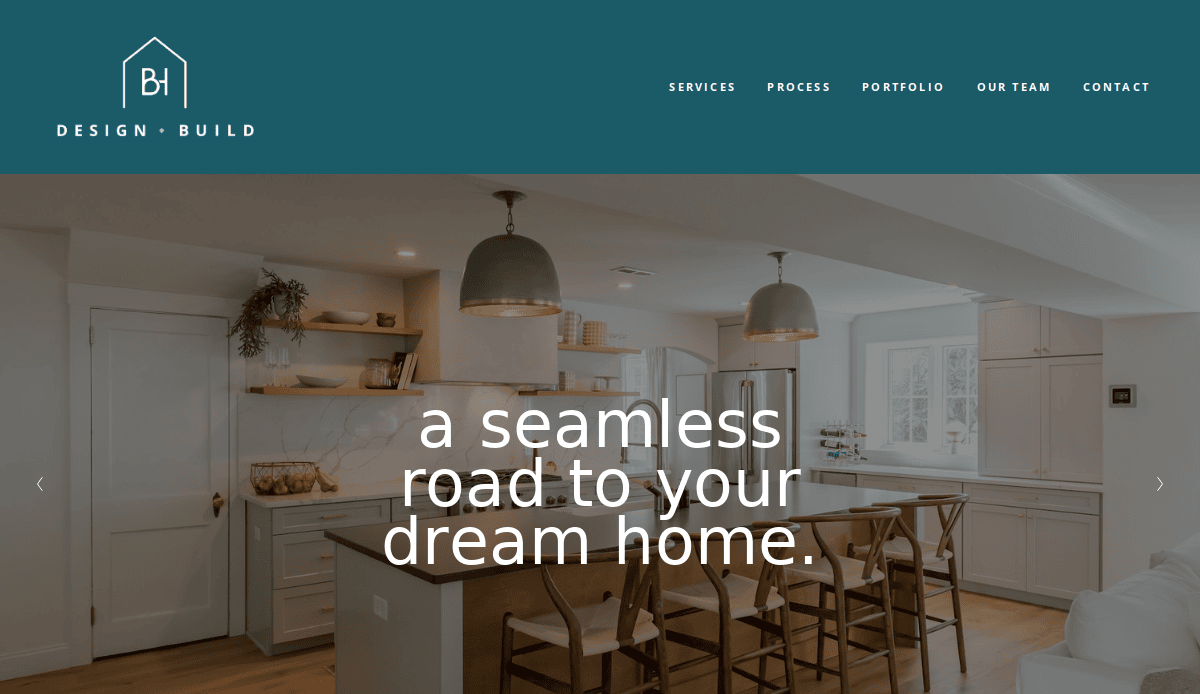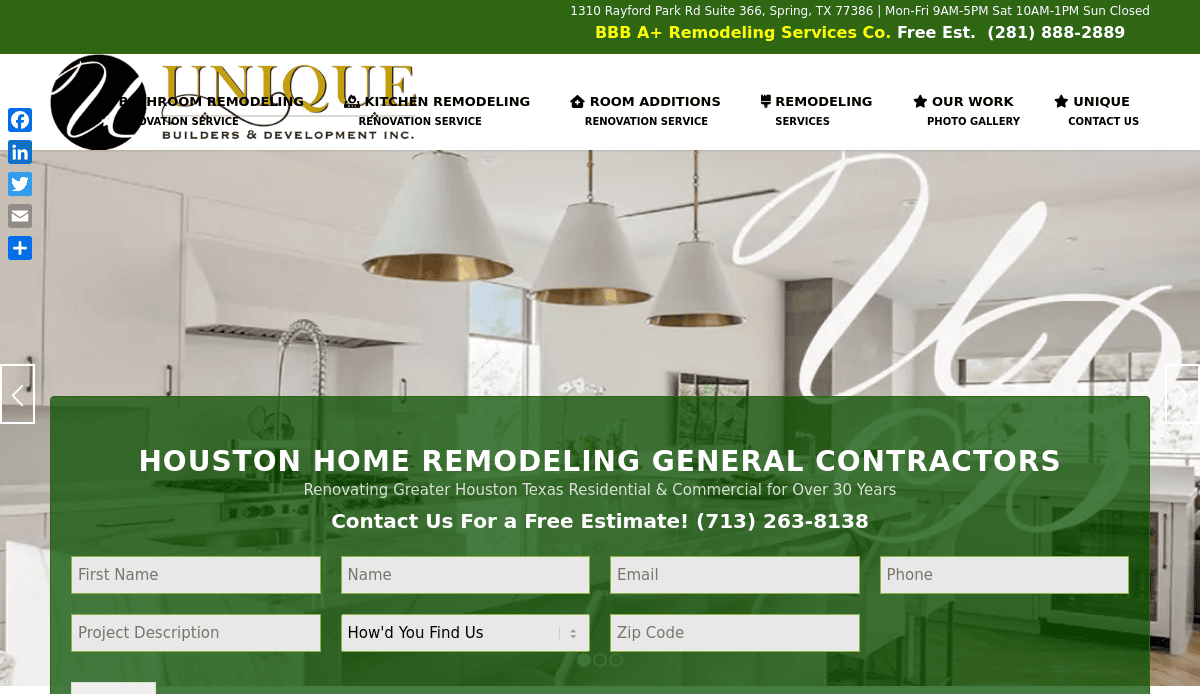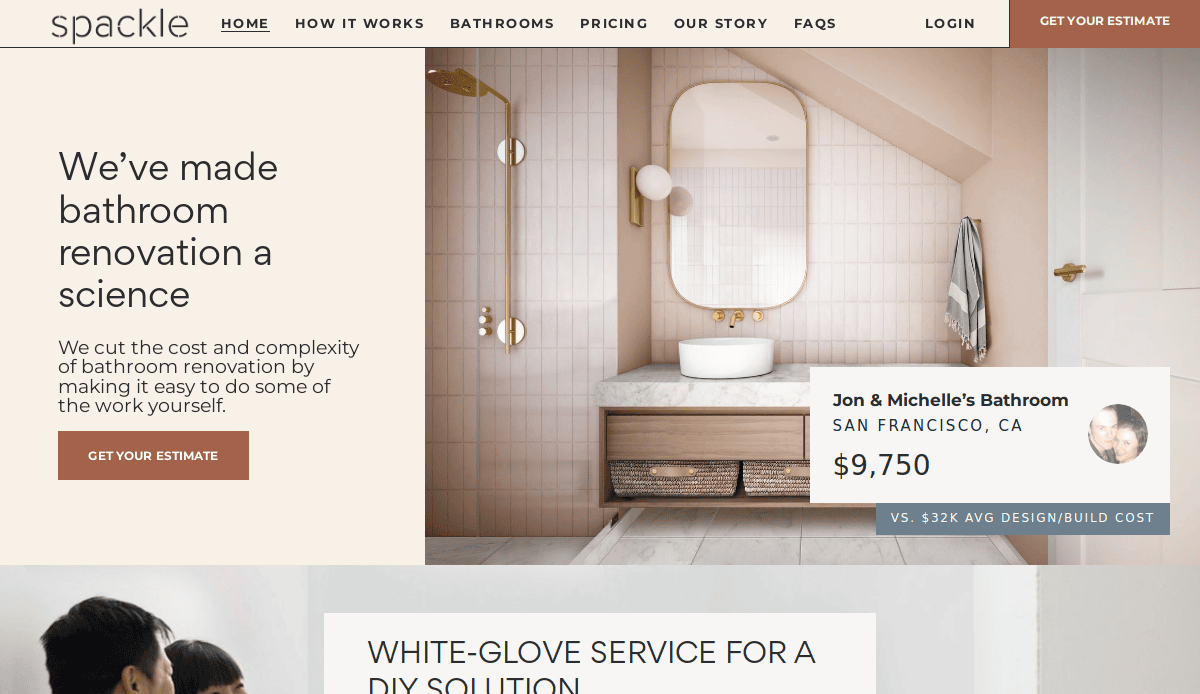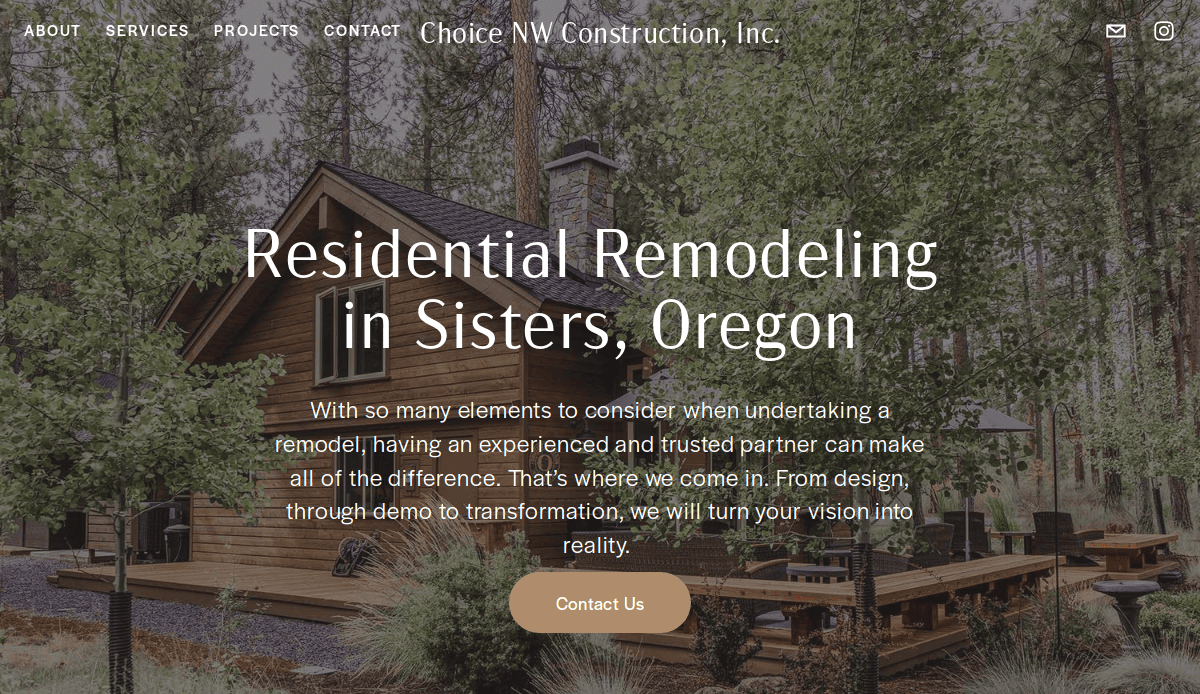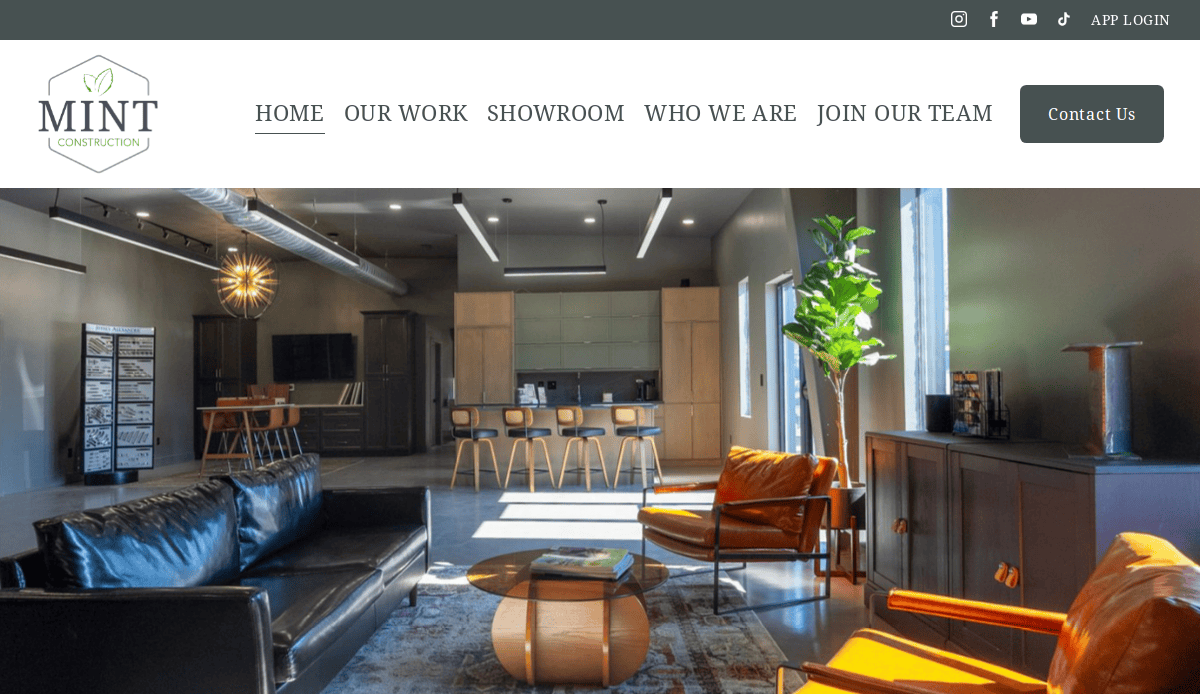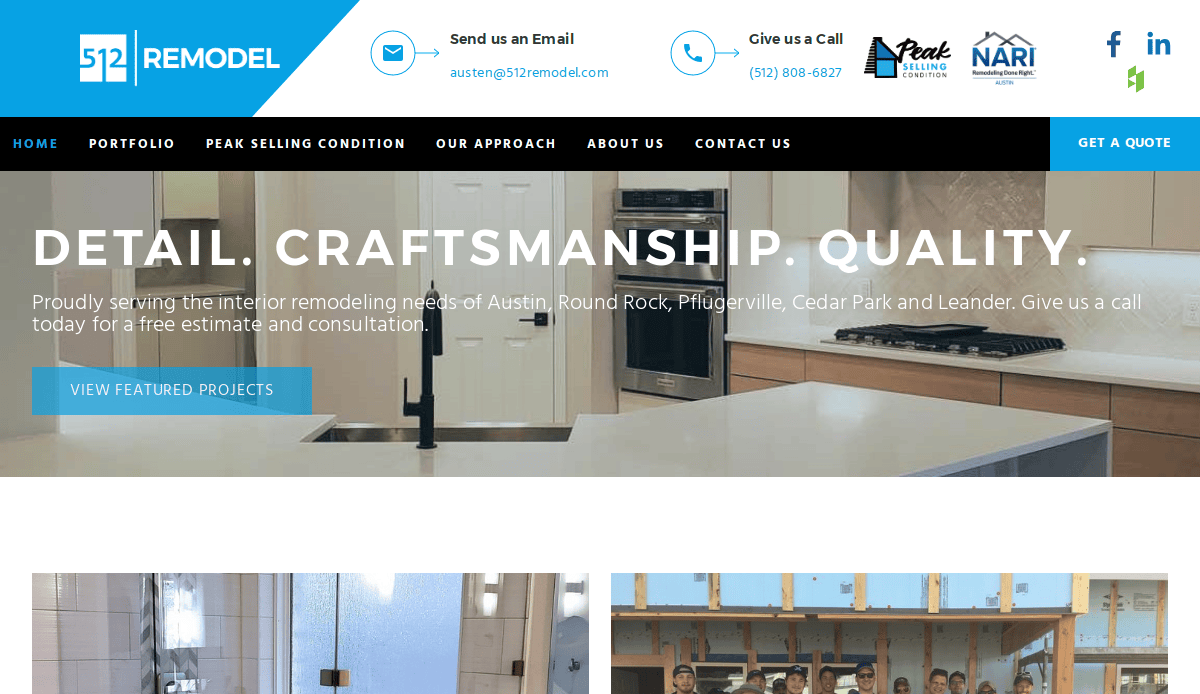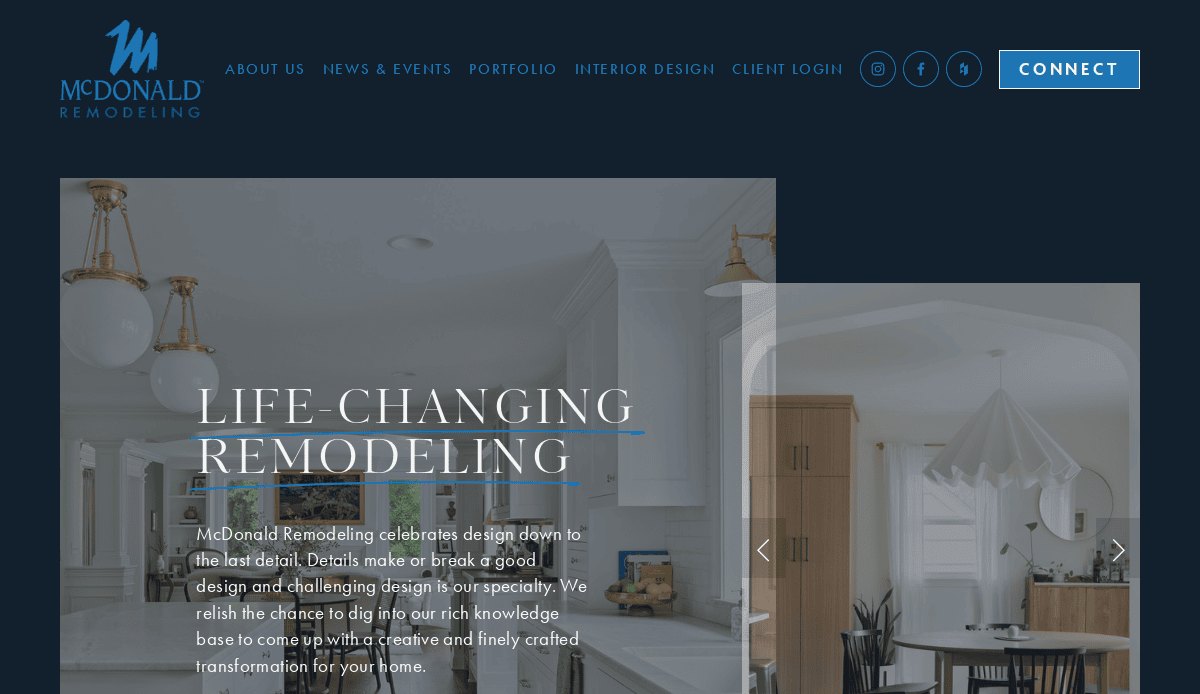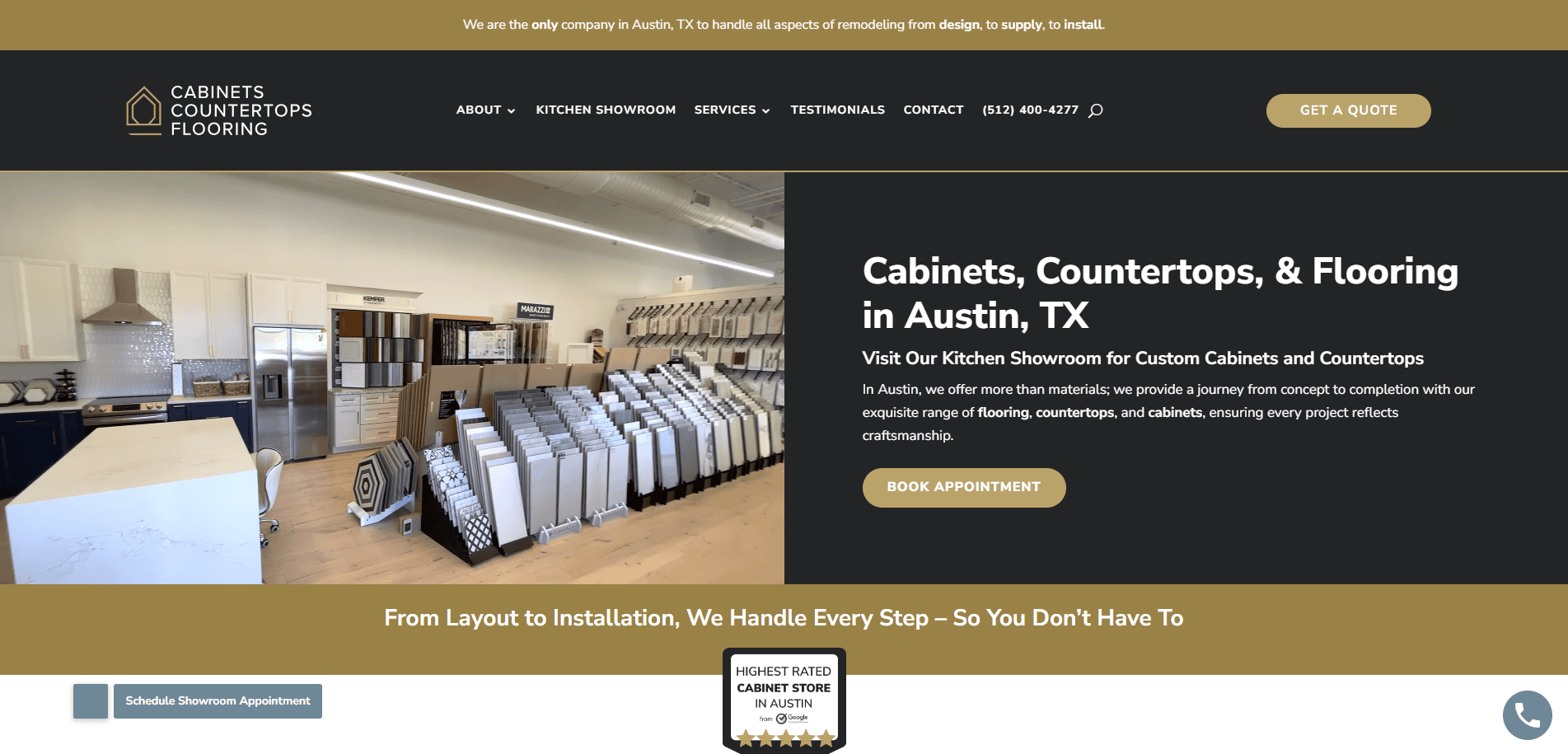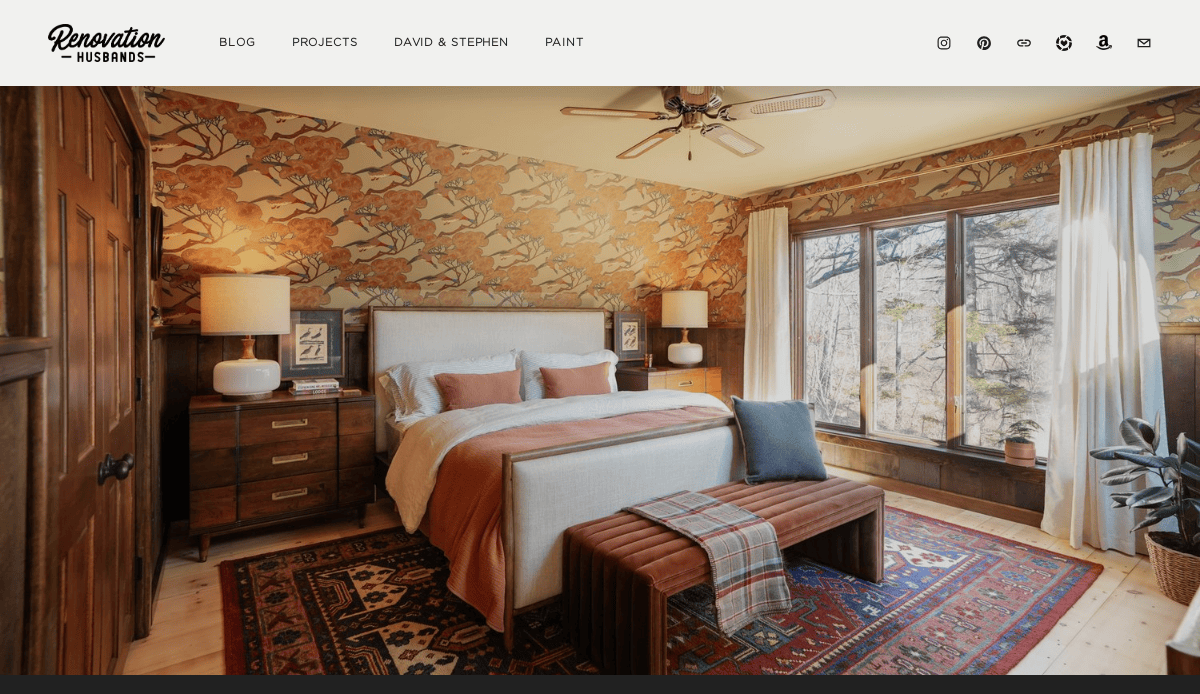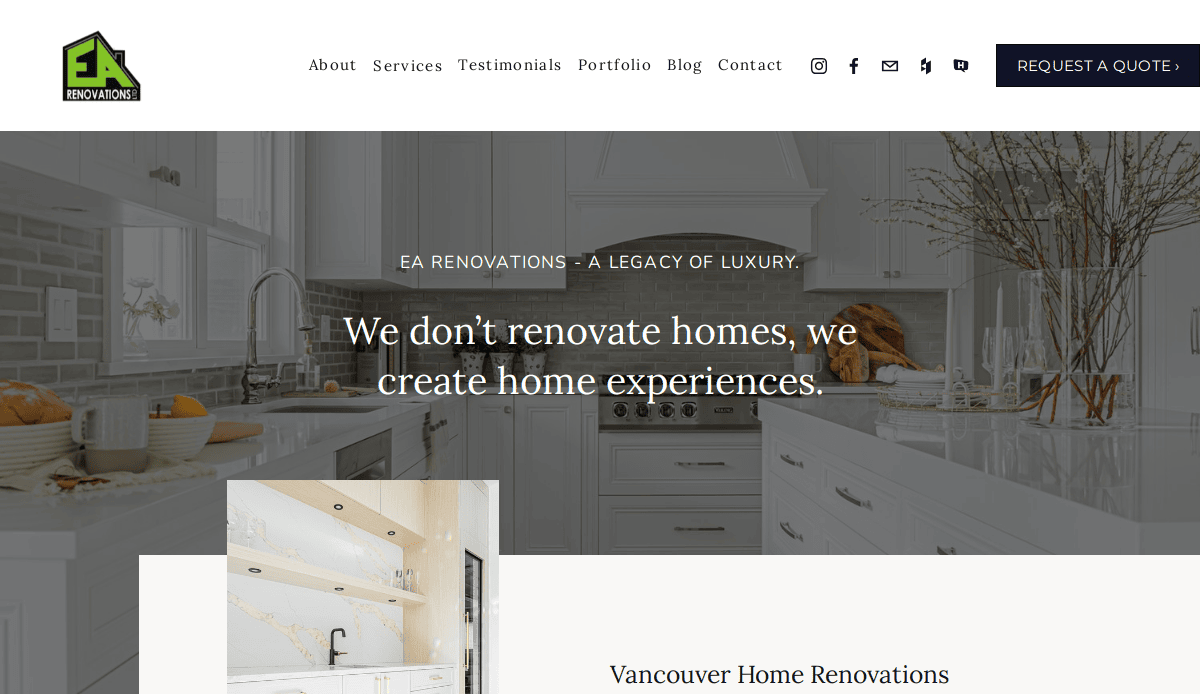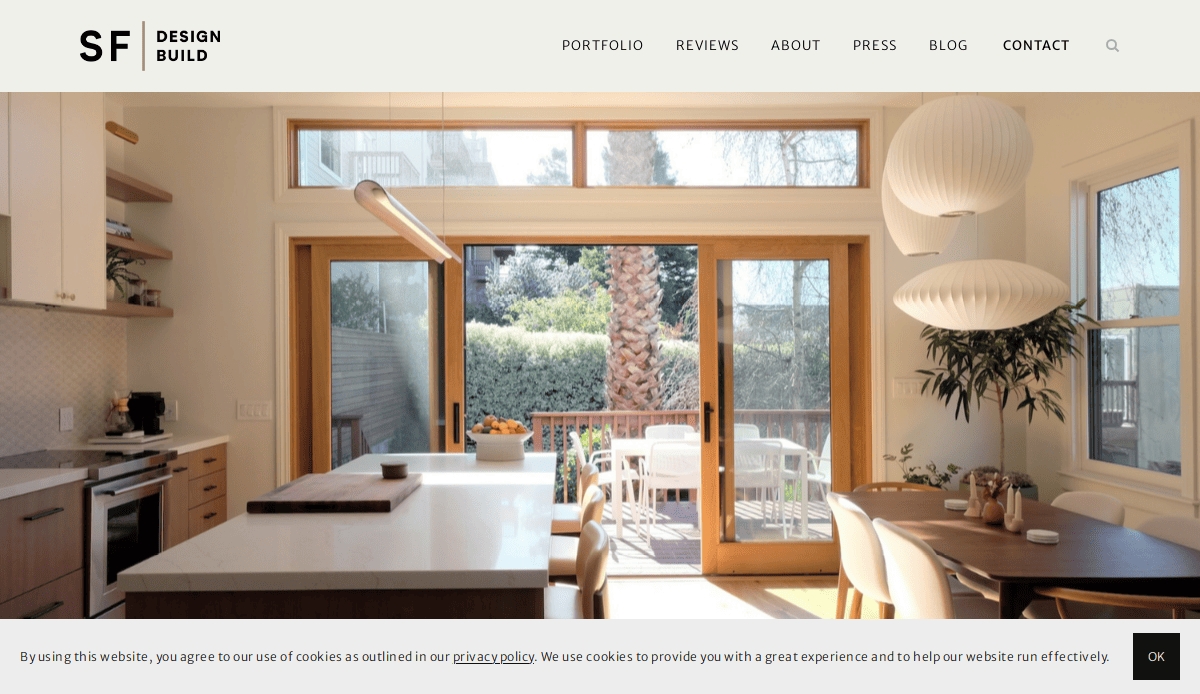Just looking for our Best Bathroom Remodeler Website examples list?
Key Takeaways
- User Experience Drives Conversions: A clean, mobile-optimized, and easy-to-navigate website significantly improves visitor engagement and lead generation.
- Visual Portfolio Is Essential: High-quality before-and-after project galleries and testimonials are must-haves to build credibility and showcase craftsmanship.
- SEO and Local Optimization Are Game Changers: Implementing localized SEO strategies—like optimized service pages, Google Business Profile integration, and schema markup—boosts visibility in local searches and AI-powered search results.
Why Your Bathroom Remodeling Business Needs a Stunning Website Design
If you’re in the bathroom remodeling industry, you already understand how visual impact, functionality, and trust are essential to winning clients. The same principles apply online—your website isn’t just a digital brochure; it’s your most powerful sales tool. Whether you’re showcasing a luxury bathroom renovation or a clever small bathroom remodel, the layout, design, and messaging of your website can either build confidence or drive prospects away.
Today’s clients are looking for clarity, trust, and results. They browse photos of past remodel projects, evaluate your bathroom design expertise, and often make contact decisions within seconds. A poorly designed website, slow load times, or outdated fixtures in your site content will hurt your credibility. On the other hand, a polished, conversion-optimized site builds authority and turns clicks into consultations.
This guide will walk you through what makes a bathroom remodeling website high-performing—from strategic layout and compelling messaging to smart SEO and visual appeal. Whether you’re preparing to launch a new business or revamp an existing site, the insights here will help your bathroom remodel brand stand out and drive real business growth. If you’re ready to remodel your online presence as skillfully as you renovate spaces, let’s begin.
Website Planning & Purpose for Bathroom Remodelers
Before the first pixel is placed or a single line of code is written, professionals need to define the purpose of their website. This foundational planning phase determines whether your site becomes a digital powerhouse or another overlooked corner of the web.
The planning process begins with understanding your target audience and what they need to see when deciding on a remodeler. For most, this includes reviewing your past bathroom renovation work, learning about your process, and feeling confident enough to schedule a consultation. Planning should involve clear goal setting—do you want to generate leads, provide education, build authority, or all of the above?
Next, outline the primary user journeys. Will homeowners be looking for inspiration through project galleries? Will they need guidance on costs and timelines for their bathroom remodel? Do you want them to call or fill out a contact form? Your layout and structure must support these pathways with intuitive navigation and strategically placed calls-to-action.
Planning also includes ensuring your site is scalable and adaptable. If you expand into kitchen remodels or new geographic areas later, your website should grow with you. This is where choosing the right platform—like WordPress—and working with a skilled design partner pays off.
Finally, determine your brand positioning. Is your focus on luxury renovation? Efficiency and speed? Budget-conscious homeowners? Every photo, headline, and page structure should reinforce your unique value proposition. A strong website strategy acts as the blueprint for every design decision that follows.
Design Principles for High-Impact Websites
Effective websites aren’t just visually attractive—they’re strategically built to convert. Strong design principles lay the groundwork for turning casual browsers into committed clients. The most effective sites in this space blend clarity, trust, and usability into every pixel.
Clarity and Simplicity: A clutter-free layout with a clear hierarchy of information ensures users instantly understand what your business does and how to take the next step. Use white space effectively to let your visuals and text breathe, and avoid design distractions that can overwhelm visitors.
Visual Hierarchy: Guide the user’s eye to the most important information first, such as your headline, core services, and a clear call-to-action like “Schedule a Consultation.” Use consistent headings, bold subheads, and strategic placement of buttons to ensure your layout supports easy navigation.
Mobile-First Design: Many clients will browse your website on mobile devices, especially while exploring bathroom design inspiration. Your site must be fully responsive with fast load times and optimized tap targets, making it easy for users to navigate and contact you on the go.
Brand Consistency: From color palette to font choice to tone of voice, your site should reflect a cohesive brand image. Whether your remodeling company emphasizes luxury, speed, or affordability, your design should support that positioning throughout every page.
Use of High-Quality Visuals: Showcase completed bathroom renovations with professionally shot before-and-after images. Let your craftsmanship speak for itself. Real photography (not stock images) adds credibility and gives potential clients confidence in your work.
Accessibility and Readability: Make sure fonts are legible, contrast is sufficient, and all users—including those with disabilities—can navigate your site with ease. Alt text for images, keyboard navigation, and properly labeled forms are all essential for ADA compliance and user experience.
Content & Navigation: Structuring for Engagement and Trust
Content and navigation are the pillars that guide users through your website and toward conversion. This means offering clear, compelling information while removing friction from the user’s path.
Homepage Essentials: Your homepage should act as a concise overview of your services, trust signals, and conversion opportunities. Use benefit-driven headlines, a clear value proposition, and strong visuals. Include a call-to-action above the fold like “Request a Free Consultation.” Reinforce trust with reviews, industry badges, or project highlights directly on the homepage.
Service Pages That Educate: Create dedicated pages for each service—bathroom remodeling, small bathroom makeovers, ADA-compliant renovations, and full renovations. These pages should clearly define the process, expected timelines, and benefits. Including FAQs and testimonials boosts SEO and provides helpful context for users comparing providers.
Project Portfolio: Visuals matter most in this industry. Include a clean, filterable portfolio with before-and-after photos, descriptions of the project goals, and design challenges solved. This demonstrates your capabilities and supports SEO by targeting localized project terms.
Navigation Structure: Keep your top-level navigation simple: Home, About, Services, Portfolio, Testimonials, Blog, Contact. Consider sticky navigation that stays visible as users scroll. Dropdown menus can be used for secondary service pages without cluttering the main menu.
Internal Linking Strategy: Guide users through your content with strategic links. For example, from a blog post about popular shower tile ideas, link to your bathroom renovation service page. From your About page, link to Testimonials to reinforce credibility.
Contact & Lead Capture: Ensure every page offers a pathway to conversion—whether it’s a contact form, phone number, or booking calendar. Embed short lead forms near the bottom of service pages and encourage action with copy like “Let’s talk about your dream bathroom remodel.” Use thank-you pages to confirm submissions and suggest additional content like project galleries.
Visual Elements: Enhancing Brand Perception and User Experience
Visual elements are more than decorative—they play a vital role in conveying credibility, enhancing user engagement, and supporting your brand identity. Every image, color, and visual asset must work in harmony to create an experience that reflects your craftsmanship and professionalism.
Professional Photography: Invest in high-resolution images of real projects. Showcase a variety of bathroom designs, layouts, and finishes to demonstrate your range and expertise. Avoid using stock photos; authenticity builds trust.
Before-and-After Galleries: These visual stories are among the most persuasive elements on a website. Present clear comparisons with consistent lighting and angles, allowing prospects to see transformation and envision their own results.
Visual Consistency: Maintain consistency in color usage, button shapes, icon styles, and font pairings across the site. This consistency strengthens brand recognition and creates a professional impression.
Icons and Infographics: Use custom icons to represent services, benefits, or steps in the remodeling process. Infographics can help simplify complex information, such as timelines, cost breakdowns, or the stages of a renovation.
Video Content: Include walk-through videos of completed bathrooms or testimonials from satisfied clients. Videos improve engagement time and humanize your brand, making visitors feel more connected and confident in your services.
Color Psychology: Choose a color palette that reflects your brand’s values—earth tones for natural elegance, blue hues for trust and cleanliness, or bold accents for modern, high-impact remodelers. Color should support both aesthetics and emotion.
Whitespace: Don’t underestimate the power of whitespace. It allows your visuals and content to stand out without overwhelming the visitor, making your site easier to scan and more enjoyable to use.
Ongoing WordPress Maintenance for Remodelers
Launching your website is just the beginning. For bathroom remodelers, consistent maintenance of your WordPress site ensures it remains secure, fast, and performing at its best. A well-maintained site continues to build trust and supports your marketing investment long after the initial design phase.
At the technical level, regular WordPress core updates, theme updates, and plugin patches are critical. Without them, your site may face vulnerabilities, slow loading speeds, or plugin conflicts that degrade the user experience. Maintenance also includes regular security scans, uptime monitoring, and automated backups to keep your site running smoothly and protect against data loss.
From a content and performance standpoint, periodic reviews of page speed, broken links, and SEO performance help keep your site competitive. Updating project galleries, client testimonials, and service areas shows search engines and visitors that your business is active and trustworthy.
Routine maintenance also supports ADA compliance and evolving browser standards. By continuously monitoring and optimizing your site, you prevent usability issues and make sure every visitor, regardless of device or ability, can access your services.
A professional maintenance plan eliminates guesswork. It allows your team to focus on remodeling projects while our experts keep your website running efficiently in the background. Reliable maintenance isn’t a luxury—it’s an essential layer of protection for your online presence.
Best Bathroom Remodeling Website Examples
1. Olympus Bathrooms
Location: United Kingdom
Key Takeaways:
- Sleek, modern design with high-quality visuals
- User-friendly navigation enhances the overall user experience
- Clear calls to action prompting user engagement
2. Saba Renovations
Location: Australia
Key Takeaways:
- Clean and modern aesthetic with a professional color scheme
- High-resolution images showcasing craftsmanship
- Organized portfolio displaying diverse remodeling projects
3. Belle Bathrooms
Location: Australia
Key Takeaways:
- Visually appealing design with strategic use of colors and typography
- High-quality project images enhance credibility
- Intuitive navigation facilitates user exploration
4. 123 Remodeling
Location: Chicago, IL
Key Takeaways:
- Striking black-and-white color scheme conveying sophistication
- High-quality photographs emphasizing attention to detail
- Accessible and well-organized navigation menu
5. BH Design & Build
Location: Los Angeles, CA
Key Takeaways:
- Sleek, contemporary design enhances visual appeal
- High-quality photos displaying portfolio and craftsmanship
- Well-organized menus with strategically placed calls to action
6. Re-Bath
Location: Phoenix, AZ
Key Takeaways:
- Clean, modern appearance with eye-catching images
- Intuitive navigation structure for seamless user experience
- Detailed service descriptions and extensive project gallery
7. Unique Builders & Development
Location: Houston, TX
Key Takeaways:
- Creative and unique bathroom design focus
- Engaging visuals with bright colors and modern fonts
- Easy navigation to services, past work, and consultation
8. Bathroom Fitter Houston
Location: Houston, TX
Key Takeaways:
- Striking image carousel showcasing products and services
- Clear calls to action for consultations and product exploration
- Customer reviews and FAQs enhance credibility
9. My Spackle
Location: Seattle, WA
Key Takeaways:
- Modern, clean design emphasizing simplicity
- Clear service offerings with a focus on DIY solutions
- Transparency in pricing and customer reviews
10. Round Lake Remodeling
Location: Round Lake, IL
Key Takeaways:
- Clear messaging with a user-friendly design
- Simple, professional look, encouraging exploration
- Effective use of icons and clear service descriptions
11. Frameworks Custom Homes
Location: Fort Collins, CO
Key Takeaways:
- Visual tour showcasing architectural designs
- Seamless portfolio integration
- Client testimonials add credibility
12. Choice NW Construction, Inc.
Location: Portland, OR
Key Takeaways:
- Engaging visuals with a tranquil forest backdrop
- Thorough service descriptions
- Testimonials blend smoothly into the design
13. Friendly Structures Design & Build
Location: Blacksburg, VA
Key Takeaways:
- Personal introductions build trust
- Crisp layout with clear service categories
- Promise section summarizes commitments effectively
14. Mint Construction VA
Location: Richmond, VA
Key Takeaways:
- High-end remodeling focuses on luxurious imagery
- Clear service descriptions
- Educational content on remodeling mistakes to avoid
15. 512 Remodel
Location: Austin, TX
Key Takeaways:
- Clean and crisp design with high-resolution images
- Easy navigation and community-conscious initiatives
- Effective use of negative space for an open feel
16. McDonald Remodeling
Location: St. Paul, MN
Key Takeaways:
- Sophisticated design with muted colors
- Neatly laid out featured projects
- Testimonials and awards enhance legitimacy
17. Cabinets, Countertops, Flooring
Location: Austin, TX
Key Takeaways:
- Luxurious feel with earth tones and stone textures
- Interactive elements with sharp imagery
- Organized project images into specific categories
18. Renovation Husbands
Location: Boston, MA
Key Takeaways:
- Cozy and historical design elements
- Engaging content, including blogs and videos
- Personal portraits adding authenticity
19. EA Renovations
Location: Vancouver, BC
Key Takeaways:
- Bold header with a focus on home experiences
- Stunning project images showcasing craftsmanship
- Client testimonials and clear service overviews
20. SF Design Build
Location: San Francisco, CA
Key Takeaways:
- Calm fusion of architecture and natural elements
- High-resolution project photos
- Clean and minimalistic footer for easy navigation
These websites exemplify effective design strategies in the bathroom redesign and remodeling industry, offering inspiration for creating a compelling online presence.
Design Your Dream Bathroom Website Today
You’ve explored what makes a professional website work, from sleek and modern design principles and clean, user-friendly layouts to showcasing your services and products with detailed service descriptions. Now it’s time to turn that insight into action. Whether you specialize in kitchens and bathrooms, offer a full range of services, or focus solely on bathroom improvement projects, your website must reflect your craftsmanship and attention to detail throughout the website.
With our top-tier web developers, you get a website that reflects your brand, streamlines your marketing efforts, and showcases your expertise and craftsmanship in bath design, floor plans, and interior design. Our websites feature a clean navigation menu, mobile-optimized performance, and are super easy to use. We support your revamp journey with templates, design tools, and case studies to guide your ideal clients from inspiration to action.
Let us help you create a website for bathroom remodeling that includes professional design solutions, user-friendly design, and calls to action that convert. Contact us today to turn your vision into reality and create a space that showcases your design styles, renovation project success, and commitment to accessibility.
FAQs: Designing High-Impact Bathroom Remodeling Websites
What makes a website’s design effective for a bath remodel business?
An effective website’s design should showcase your expertise and attention to detail, use a clean and user-friendly layout, and guide visitors through the design process with visual proof of your craftsmanship. Highlight your range of services and include calls to action that make it easy to schedule a consultation.
How can I showcase my design ideas and restoration work online?
Include high-quality galleries of your best projects, featuring before-and-after photos and specific design details like custom tilework or lighting. Add case studies to support your bath remodel process and show your top-notch bathroom transformations. Keep your layout clean to enhance the overall user experience.
What content should be on a kitchen and bathroom remodeling website?
Your site should feature detailed service descriptions for kitchen and bathroom remodeling, highlight your design tips and solutions, and include trust-building elements like testimonials and project timelines. Include sections about your design styles and your approach to the design for bathroom remodel projects.
How can I create the bathroom of your dreams through my website?
Use strategic content and layout to show clients what’s possible. Share your bath design process, floor plans, and inspiration boards. Provide downloadable templates or design guides to help visitors envision their dream bathroom with ease. Clear navigation and engaging visuals make all the difference.
Why is a clean and user-friendly design important for my remodeling site?
Remodeling clients often browse on mobile and want answers fast. A modern, clean layout improves the overall user experience and keeps visitors engaged. It also improves search rankings and makes your site more accessible—two key elements of professional web design. Learn how we maintain top performance.
Should my website include both bathroom and kitchen remodeling content?
Yes, if you offer both services. Include separate pages or sections that clearly explain each service and its benefits. This approach improves SEO and ensures that visitors find the content relevant to their project, whether that’s a new bathroom or a kitchen upgrade.
What role do design and content play in converting visitors?
Design and content work together to build trust and guide action. Your content should answer common questions, explain your design process, and reflect your expertise. Your design should highlight these elements and direct users to convert through well-placed buttons and forms. See how we boost conversions.
Can I redesign my existing bathroom website without losing SEO?
Yes, with proper planning. Maintain your existing URLs when possible, redirect outdated pages, and enhance your site with fresh content and improved usability. A professional redesign strengthens your online presence and retains your rankings.
How often should I update my remodeling website?
Update project galleries quarterly, publish new blog posts monthly, and review your service pages every six months to keep your content current. Regular updates reflect ongoing work and align with evolving bathroom trends.
What’s the first step in designing a new bathroom remodeling site?
Start by identifying your target audience and defining your service scope. Gather assets like project photos, design details, and testimonials. Then work with a team that understands how to translate your design tips and renovation expertise into a clean, modern website.

